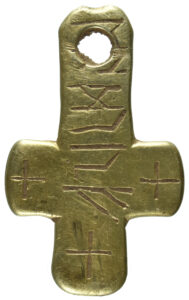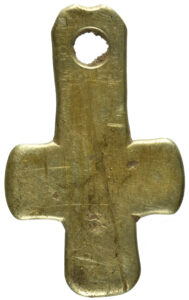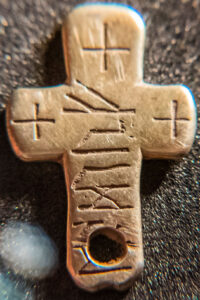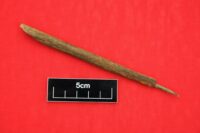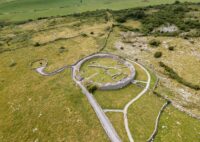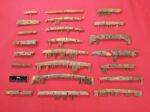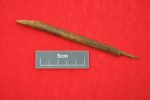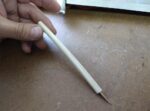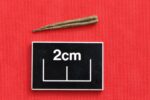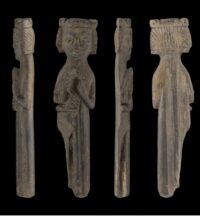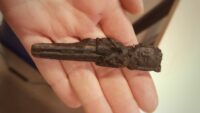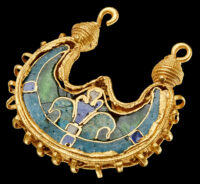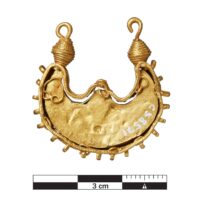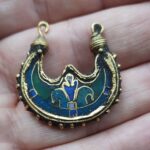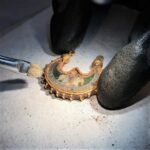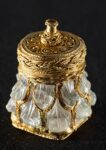 An extraordinary carved rock crystal jar from the Galloway Hoard has been cleaned and conserved by experts at the National Museums Scotland (NMS), revealing it to be a Roman crystal jar wrapped in elaborate layers of gold thread from the late 8th or early 9th century. The base is inscribed with the name of an Anglo-Saxon bishop, strong evidence that some of the treasures in the hoard were taken from a church in the early medieval Anglo-Saxon Kingdom of Northumbria.
An extraordinary carved rock crystal jar from the Galloway Hoard has been cleaned and conserved by experts at the National Museums Scotland (NMS), revealing it to be a Roman crystal jar wrapped in elaborate layers of gold thread from the late 8th or early 9th century. The base is inscribed with the name of an Anglo-Saxon bishop, strong evidence that some of the treasures in the hoard were taken from a church in the early medieval Anglo-Saxon Kingdom of Northumbria.
The richest Viking assemblage of high-status objects ever found in Britain or Ireland, the Galloway Hoard was discovered by a metal detectorist in a field near Castle Douglas in Dumfries and Galloway, Scotland in September 2014. After a major fundraising campaign, National Museums Scotland was able to acquire the hoard for an ex gratia payment of £1.98 million 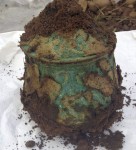 ($2,550,000) in 2017. Years of complex examination, conservation and cleaning ensued, revealing an astonishing wealth of rare objects including a silver pectoral cross with niello enamel decoration that is unique on the archaeological record, a gold bird-shaped pin, also unique, and a silver-gilt pot of a type known to have been produced in the Carolingian Empire which is one of only three known from Britain and the only one of them found complete with its original lid.
($2,550,000) in 2017. Years of complex examination, conservation and cleaning ensued, revealing an astonishing wealth of rare objects including a silver pectoral cross with niello enamel decoration that is unique on the archaeological record, a gold bird-shaped pin, also unique, and a silver-gilt pot of a type known to have been produced in the Carolingian Empire which is one of only three known from Britain and the only one of them found complete with its original lid.
The pot was wrapped in woven textiles. To preserve them and excavate the interior as cautiously as possible, conservators had the pot CT scanned, revealing the treasures packed inside, including a 9th century Anglo-Saxon brooch, an Irish penannular brooch, a gold reliquary pendant and a hinged silver strap. Each object was wrapped in a precious textile like silk samite or fine leather.
While much of the Galloway Hoard outside of the pot has toured Scotland and is currently on display at Kirkcudbright Galleries in the hoard’s home region of Dumfries and Galloway, the vessel and its contents are undergoing a three-year project of meticulous conservation and research.
The project has already born extraordinary results. A 3D model created from X-ray imaging that captured the surface of the pot obscured beneath the fabric wrapping revealed it is not of Carolingian origin at all. The iconography of leopards, tigers and Zoroastrian symbols is typical of Sasanian Empire (224-651 A.D.) art, which means this vessel came from Persia, not continental Europe. Radiocarbon dating of textile samples from the three layers wrapped around the vessel found it was produced between 680 and 780 A.D., so it was 100-200 years old by the time the hoard was buried.
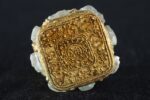 One of the objects inside the vessel was the rock crystal jar. When it was first removed, it was bundled in a textile wrapping that proved to be a silk-lined leather pouch. 3D X-ray imagining saw through the wrapping to the object within and revealed the Latin inscription on the base which read: “Bishop Hyguald had me made.”
One of the objects inside the vessel was the rock crystal jar. When it was first removed, it was bundled in a textile wrapping that proved to be a silk-lined leather pouch. 3D X-ray imagining saw through the wrapping to the object within and revealed the Latin inscription on the base which read: “Bishop Hyguald had me made.”
Conservators painstakingly removed the pouch and cleaned the rock 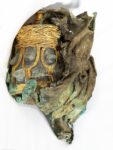 crystal. They found from the surface of the jar that it started out as the capital of Corinthian column made of rock crystal in the late Roman Empire. At some point over the next 500 years, the capital of the crystal column was converted into a jar and wrapped in gold thread.
crystal. They found from the surface of the jar that it started out as the capital of Corinthian column made of rock crystal in the late Roman Empire. At some point over the next 500 years, the capital of the crystal column was converted into a jar and wrapped in gold thread.
There is the possibility that this jar still bears trace elements of the potion it once held and that its precise chemicals can be revealed.
[Dr. Martin Goldberg, NMS’s principal curator of early medieval and Viking collections] said: “The type of liquid that we would expect would be something very exotic, perhaps a perfume from the Orient, something’s that’s travelled in the same way that the silk has. There were certain types of exotic oil that were used in anointing kings and ecclesiastical ceremonies.”
Below are the 3D models of the rock crystal jar before and after conservation.
